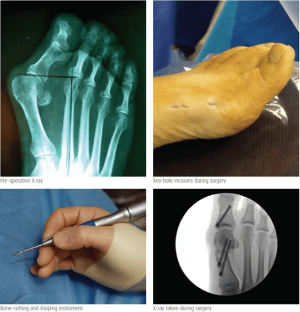
Minimally-invasive (keyhole) foot surgery is a type of foot surgery that is performed using small incisions and specialised instruments. It is also known as percutaneous surgery or minimally invasive surgery (MIS). This type of surgery is designed to minimise tissue trauma, reduce postoperative pain and swelling, and speed up recovery time compared to traditional open surgery.
During the surgery, the surgeon will make small incisions in the skin and insert specialised instruments, such as cameras and small cutting tools, to perform the procedure. Because the incisions are smaller, there is less tissue trauma and bleeding, and patients typically experience less pain and scarring.
Minimally-invasive foot surgery can be used to treat a variety of foot and ankle conditions, including bunions, hammertoes, plantar fasciitis, neuromas, and Achilles tendon injuries. The suitability of this type of surgery depends on the individual patient’s condition and medical history, as well as the surgeon’s experience and expertise.
Benefits of minimally-invasive foot surgery include a shorter recovery time, reduced pain and swelling, less scarring, and a lower risk of infection. However, there are also potential risks and complications associated with any type of surgery, so it is important to discuss the benefits and risks with your doctor before making a decision about treatment.
